|
|
|
Sort Order |
|
|
|
Items / Page
|
|
|
|
|
|
|
| Srl | Item |
| 1 |
ID:
112904


|
|
|
|
|
| Publication |
2012.
|
| Summary/Abstract |
In 2008, the gross domestic product (GDP) of California industry was larger than GDP of industry in any other U.S. states. This study analyses the energy use of and output from seventeen industry subsectors in California and performs decomposition analysis to assess the influence of different factors on California industry energy use. The logarithmic mean Divisia index method is used for the decomposition analysis. The decomposition analysis results show that the observed reduction of energy use in California industry since 2000 is the result of two main factors: the intensity effect and the structural effect. The intensity effect has started pushing final energy use downward in 2000 and has since amplified. The second large effect is the structural effect. The significant decrease of the energy-intensive "Oil and Gas Extraction" subsector's share of total industry value added, from 15% in 1997 to 5% in 2008, and the increase of the non-energy intensive "Electric and electronic equipment manufacturing" sector's share of value added, from 7% in 1997 to 30% in 2008, both contributed to a decrease in the energy intensity in the industry sector.
|
|
|
|
|
|
|
|
|
|
|
|
|
|
|
|
| 2 |
ID:
112913
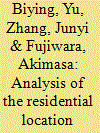

|
|
|
|
|
| Publication |
2012.
|
| Summary/Abstract |
It is expected that the residential location choice and household energy consumption behavior might correlate with each other. Besides, due to the existence of self-selection effects, the observed inter-relationship between them might be the spurious result of the fact that some unobserved variables are causing both. These concerns motivate us to (1) consider residential location choice and household energy consumption behavior (for both in-home appliances and out-of-home cars) simultaneously and, (2) explicitly control self-selection effects so as to capture a relatively true effect of land-use policy on household energy consumption behavior. An integrated model termed as joint mixed Multinomial Logit-Multiple Discrete-Continuous Extreme Value model is presented here to identify the sensitivity of household energy consumption to land use policy by considering multiple self-selection effects. The model results indicate that land-use policy do play a great role in changing Beijing residents' energy consumption pattern, while the self-selection effects cannot be ignored when evaluating the effect of land-use policy. Based on the policy scenario design, it is found that increasing recreational facilities and bus lines in the neighborhood can greatly promote household's energy-saving behavior. Additionally, the importance of "soft policy" and package policy is also emphasized in the context of Beijing.
|
|
|
|
|
|
|
|
|
|
|
|
|
|
|
|
| 3 |
ID:
112933


|
|
|
|
|
| Publication |
2012.
|
| Summary/Abstract |
Increasing international biomass trade for energy and concerns about sustainability of globally traded biomass have raised interest in assessments of cross-border trade related to bioenergy. Within this paper, approaches to overcome methodological difficulties related to biomass trade are proposed and applied for the case of Austria.
Biomass currently has a share of 15.5% in Austria's primary energy consumption of 1354 PJ (2009). According to energy statistics, the rate of self-sufficiency with biomass for energy (defined as the ratio of domestic production to inland consumption, with both imports and exports taken into account) is 91%. However, feedstock imports for transport fuel production and indirect imports of wood-based fuels (wood processing residues and waste liquor of the paper industry originating from imported wood) are not taken into account in energy statistics, but prove to be of some significance. Imports of agricultural commodities to the amount of 9.7 PJ can be attributed to domestic biofuel production, and indirect imports of wood-based fuels, account for 31 PJ. With these import streams taken into account, the share of domestic fuels in bioenergy use is only 67%, rather than 84%, as official energy statistics suggest. On the other hand, Austria is exporting more than 50% of its production of sawnwood, panelboard and paper products.
|
|
|
|
|
|
|
|
|
|
|
|
|
|
|
|
| 4 |
ID:
112935


|
|
|
|
|
| Publication |
2012.
|
| Summary/Abstract |
Nuclear power currently supports the goals of the European Union low-carbon society by being a dependable source of energy, while emitting no CO2. In the future, more flexible nuclear systems could enable wind to achieve a 50% share of the renewable contribution to the energy mix. Small and medium-sized reactors (SMRs) could provide firming power generation to back-up the supply from renewable resources and follow-load. This study involves the hypothetical combination of an off-shore wind farm and a SMR, operated together as a virtual power plant (VPP). Results using wind data from the North Sea indicate that the combination results in 80% less wind power variation to the grid, effectively creating a virtual baseload power plant. This gain comes at the loss of 30% SMR capacity utilization. The research identified that the reduction of 1000 MW off-shore wind farm variability was best achieved with 700 MW SMRs using 100 MW modules. In demand-following mode the VPP could maneuver output to improve synchronization with demand by 60-70% over a wind-only system. Power variability was indifferent to the SMR module size. The VPP could not reduce 100% of the wind variation, as additional balancing measures (e.g., smart grid, storage, and hybrid-nuclear systems) are still needed.
|
|
|
|
|
|
|
|
|
|
|
|
|
|
|
|
| 5 |
ID:
112906


|
|
|
|
|
| Publication |
2012.
|
| Summary/Abstract |
Local authorities often rely upon urban energy and carbon modelling tools to develop mitigation policies and strategies that will deliver reductions in greenhouse gas emissions. In this paper the UK example of Newcastle-upon-Tyne is used to critique current practice, noting that important features of urban energy systems are often omitted by bottom-up tools including interactions between technologies, spatial disaggregation of demand, and the ability to pursue over-arching policy goals like cost minimization. An alternative optimization-based approach is then described and applied to the Newcastle case, at the scale of both the whole city and the South Heaton district, and using Monte Carlo techniques to address policy uncertainty. The results show that this new method can help policy makers draw more robust policy conclusions, sensitive to spatial variations in energy demand and capturing the interactions between developments in the national energy system and local policy options. Further work should focus on improving our understanding of local building stocks and energy demands so as to better assess the potential of new technologies and policies.
|
|
|
|
|
|
|
|
|
|
|
|
|
|
|
|
| 6 |
ID:
112888


|
|
|
|
|
| Publication |
2012.
|
| Summary/Abstract |
The emergent industry of indoor Cannabis production - legal in some jurisdictions and illicit in others - utilizes highly energy intensive processes to control environmental conditions during cultivation. This article estimates the energy consumption for this practice in the United States at 1% of national electricity use, or $6 billion each year. One average kilogram of final product is associated with 4600 kg of carbon dioxide emissions to the atmosphere, or that of 3 million average U.S. cars when aggregated across all national production. The practice of indoor cultivation is driven by criminalization, pursuit of security, pest and disease management, and the desire for greater process control and yields. Energy analysts and policymakers have not previously addressed this use of energy. The unchecked growth of electricity demand in this sector confounds energy forecasts and obscures savings from energy efficiency programs and policies. While criminalization has contributed to the substantial energy intensity, legalization would not change the situation materially without ancillary efforts to manage energy use, provide consumer information via labeling, and other measures. Were product prices to fall as a result of legalization, indoor production using current practices could rapidly become non-viable.
|
|
|
|
|
|
|
|
|
|
|
|
|
|
|
|
| 7 |
ID:
112917


|
|
|
|
|
| Publication |
2012.
|
| Summary/Abstract |
This paper explores the relationship between CO2 emissions and economic activity for 31 countries (28 OECD, Brazil, China, and India) during the period 1950 to 2006 using cointegration analysis. Single country long run relationships are estimated, and equality in the functional form, the parameters, and the turning point, when appropriate, are rejected. This confirms the relevance of considering the differences among countries in the relationship between air pollution and economic activity to avoid wrong estimations and conclusions.
|
|
|
|
|
|
|
|
|
|
|
|
|
|
|
|
| 8 |
ID:
112936
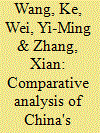

|
|
|
|
|
| Publication |
2012.
|
| Summary/Abstract |
Measuring and improving the energy performance with considering emission constraints is an important issue for China's energy conservation, pollutant emissions reduction and environment protection. This study utilizes several data envelopment analysis (DEA) based models to evaluate the total-factor energy and emission performance of China's 30 regions within a joint production framework of considering desirable and undesirable outputs as well as separated energy and non-energy inputs. DEA window analysis is applied in this study to deal with cross-sectional and time-varying data, so as to measure the performance during the period of 2000-2009. Two treatments for undesirable outputs are combined with DEA models and the associated indicators for simplex energy performance and unified energy and emission performance measurement are proposed and compared. The evaluation results indicate that the treatment of undesirable outputs transformation is more appropriate for China's regional energy and emission performance evaluation because it has stronger discriminating power and can provide more reasonable evaluation results that characterize China's regions. The empirical result shows that east China has the highest and the most balanced energy and emission performance. The energy and emission performance of China remained stable during 2000-2003, decreased slightly during 2004-2006, and has continuously increased since 2007.
|
|
|
|
|
|
|
|
|
|
|
|
|
|
|
|
| 9 |
ID:
112886


|
|
|
|
|
| Publication |
2012.
|
| Summary/Abstract |
Energy security1 is one of the main targets of energy policy. However, the term has not been clearly defined, which makes it hard to measure and difficult to balance against other policy objectives.
We review the multitude of definitions of energy security. They can be characterized according to the sources of risk, the scope of the impacts, and the severity filters in the form of the speed, size, sustention, spread, singularity and sureness of impacts. Using a stylized case study for three European countries, we illustrate how the selection of conceptual boundaries along these dimensions determines the outcome. This can be avoided by more clearly separating between security of supply and other policy objectives. This leads us to the definition of energy security as the continuity of energy supplies relative to demand.
|
|
|
|
|
|
|
|
|
|
|
|
|
|
|
|
| 10 |
ID:
112897


|
|
|
|
|
| Publication |
2012.
|
| Summary/Abstract |
This paper investigates the economic implications of disruptions of one to ninety days to the supply of natural gas in Ireland. We assess the impact of a hypothetical gas supply disruption in both winter and summer in 2008 (with observed market characteristics) and in 2020 (with projected market characteristics). The cost of a natural gas outage includes the cost of natural gas being unavailable for heating and other purposes in the industrial and commercial sectors, lost consumer surplus in the residential sector, the cost of lost electricity in all sectors and lost VAT on the sale of gas and electricity. Ireland generates much of its electricity from natural gas and the loss of this electricity accounts for the majority of the cost of a natural gas outage. Losing gas-fired electricity would cost 0.1-1.0 billion euro per day, depending on the time to the week, the time of year and rationing. Industry should be rationed before households to minimise economic losses, but current emergency protocols do the opposite. If gas-fired electricity is unavailable for three months, the economic loss could be up to 80 billion euro, about half of Gross Domestic Product. Losing gas for heating too would add up to approximately 8 billion euro in economic losses. We also discuss some options to increase Ireland's security of supply, and find that the cost is a small fraction of the avoided maximum damage.
|
|
|
|
|
|
|
|
|
|
|
|
|
|
|
|
| 11 |
ID:
112902


|
|
|
|
|
| Publication |
2012.
|
| Summary/Abstract |
Most existing energy efficiency indices are computed without taking into account undesirable outputs such as CO2 and SO2 emissions. This paper computes the ecological total-factor energy efficiency (ETFEE) of 30 regions in China for the period 2005-2009 through the slack-based model (SBM) with undesirable outputs. We calculate the ETFEE index by comparing the target energy input obtained from SBM with undesirable outputs to the actual energy input. Findings show that China's regional ETFEE still remains a low level of around 0.600 and regional energy efficiency is overestimated by more than 0.100 when not looking at environmental impacts. China's regional energy efficiency is extremely unbalanced: the east area ranks first with the highest ETFEE of above 0.700, the northeast and central areas follow, and the west area has the lowest ETFEE of less than 0.500. A monotone increasing relation exists between the area's ETFEE and China's per capita GDP. The truncated regression model shows that the ratio of R&D expenditure to GDP and the degree of foreign dependence have positive impacts, whereas the ratio of the secondary industry to GDP and the ratio of government subsidies for industrial pollution treatment to GDP have negative effects, on the ETFEE.
|
|
|
|
|
|
|
|
|
|
|
|
|
|
|
|
| 12 |
ID:
112890
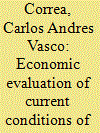

|
|
|
|
|
| Publication |
2012.
|
| Summary/Abstract |
This study uses microeconomic data from the transportation systems of land cargo in Colombia: rail and trucking, to determine their degree of allocative efficiency through the non-parametric method Data Envelopment Analysis DEA. The average overall efficiency found was 74.4% for trains and 20.56% for trucks. These figures indicate that rail is more efficient in the allocation of resources. This means that trains in Colombia use their input better than trucks to maximize their production, given the costs and technological characteristics of each system. This is a signal for the design of a public policy for investment in transportation infrastructure that seeks to raise the competitiveness of Colombian exports, investing not only in roads but in complementary systems such as railways too.
|
|
|
|
|
|
|
|
|
|
|
|
|
|
|
|
| 13 |
ID:
112932
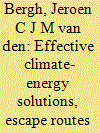

|
|
|
|
|
| Publication |
2012.
|
| Summary/Abstract |
Many well-intended climate-energy strategies are ineffective in the absence of serious environmental regulation. This holds, among others, for direct support of clean energy, voluntary energy conservation, technical standards on a limited set of products, unilateral stringent carbon pricing, and awaiting peak oil as a climate strategy. All of these suffer from "escape routes" that indirectly increase CO2 emissions and thus make the original strategy ineffective. On the other hand, environmental regulation alone may lead to a myopia-bias, stimulating early dominance of cost-effective technologies and a focus on incremental innovations associated with such technologies rather than on radical innovations. Although adopting a partial viewpoint keeps the analysis simple, we urgently need a more inclusive systems perspective on climate solutions. This will allow the formulation of an effective climate policy package that addresses the various escape routes.
|
|
|
|
|
|
|
|
|
|
|
|
|
|
|
|
| 14 |
ID:
112920


|
|
|
|
|
| Publication |
2012.
|
| Summary/Abstract |
This study quantifies the effects of aggregating electric load over various combinations (Aggregation Groupings) of the 10 Federal Energy Regulatory Commission (FERC) regions in the contiguous U.S. Generator capacity capital cost savings, load energy shift operating cost savings, reserve requirement cost savings, and transmission costs due to aggregation were calculated for each Aggregation Grouping. Eight scenarios of Aggregation Groupings over the U.S. were formed to estimate overall system cost. Transmission costs outweighed cost savings due to aggregation for all scenarios and nearly all Aggregation Groupings. East-west transmission layouts had the highest overall cost, and interconnecting ERCOT to adjacent FERC Regions resulted in increased costs, both due to limited existing transmission capacity. This study found little economic benefit of aggregating electric load alone (e.g., without aggregating renewable generators simultaneously), except in the West and Northwest U.S. If aggregation of load alone is desired, small, regional consolidations yield the lowest overall cost. This study neither examines nor precludes benefits of interconnecting geographically-dispersed renewable generators with load. It also does not consider effects from sub-hourly load variability, fuel diversity and price uncertainty, energy price differences due to congestion, or uncertainty due to forecasting errors; thus, results are valid only for the assumptions made.
|
|
|
|
|
|
|
|
|
|
|
|
|
|
|
|
| 15 |
ID:
112921


|
|
|
|
|
| Publication |
2012.
|
| Summary/Abstract |
The accumulation and maintenance of emergency oil stocks in accordance with the requirements of the European Union involve changes in legislation, the strengthening of national stockholding institutions and the attraction of investment. Despite these challenges, almost all Southeastern and Eastern European countries have begun to align their oil stockholding arrangements with the European model, albeit there is variation in the actual degree of convergence. The greatest convergence is observed for Croatia and the Former Yugoslav Republic of Macedonia. In marked contrast, the oil stockholding system of Moldova continues to be different from the European model. This study provides an overview of the Southeastern and Eastern European countries' progress in approximating the European requirements for emergency oil stocks and identifies the factors responsible for the cross-country variation. The differences observed stem from the extent to which the countries are legally obliged to comply with the European provisions, their membership aspirations, levels of energy-related investment from the European Union, and dependence on oil imports.
|
|
|
|
|
|
|
|
|
|
|
|
|
|
|
|
| 16 |
ID:
112894


|
|
|
|
|
| Publication |
2012.
|
| Summary/Abstract |
To meet ambitious global climate targets, mitigation effort in China and India is necessary. This paper presents an analysis of the scientific literature on how effort-sharing approaches affect emission allowances and abatement costs of China and India. We find that reductions for both China and India differ greatly in time, across- and within approaches and between concentration stabilisation targets. For China, allocated emission allowances in 2020 are substantially below baseline projections. Moreover, they may be below 2005 emission levels, particularly for low concentration targets (below 490 ppm CO2-eq). Effort-sharing approaches based on allocating reduction targets lead to relatively lower reductions for China than approaches that are based on allocating emission allowances. For 2050, emission allowances for China are 50-80% below 2005 levels for low concentration targets with minor differences between approaches. Still, mitigation costs of China (including emissions trading) remain mostly below global average. According to literature, Chinese emission allowances peak before 2025-2030 for low concentration targets. India's emission allowances show high increases compared to 2005 levels. If emission trading is allowed, financial revenues from selling credits might compensate mitigation costs in most approaches, even for low concentration targets. India's emission allowances peak around 2030-2040 for all concentration targets.
|
|
|
|
|
|
|
|
|
|
|
|
|
|
|
|
| 17 |
ID:
112915
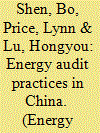

|
|
|
|
|
| Publication |
2012.
|
| Summary/Abstract |
China set an ambitious goal of reducing its energy use per unit of GDP by 20% between 2006 and 2010. Much of the country's effort is focused on improving the energy efficiency of the industrial sector, which consumes about two-thirds of China's primary energy. Industrial energy audits are an important part of China's efforts to improve its energy intensity. Such audits are employed to help enterprises identify energy-efficiency improvement opportunities and serve as a means to collect critical energy-consuming information. Information about energy audit practices in China is, however, little known to the outside world. This study combines a review of China's national policies and programs on energy auditing with information collected from surveying a variety of Chinese institutions involved in energy audits. A key goal of the study is to conduct a gap analysis to identify how current practices in China related to energy auditing differ from energy auditing practices found around the world. This article presents our findings on the study of China's energy auditing practices at the national and provincial levels. It discusses key issues related to the energy audits conducted in China and offers policy recommendations that draw upon international best practices.
|
|
|
|
|
|
|
|
|
|
|
|
|
|
|
|
| 18 |
ID:
112937
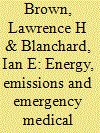

|
|
|
|
|
| Publication |
2012.
|
| Summary/Abstract |
Understanding the energy consumption and emissions associated with health services is important for minimizing their environmental impact and guiding their adaptation to a low-carbon economy. In this post-hoc analysis, we characterize the energy burden of North American emergency medical services (EMS) agencies and estimate the potential marginal damage costs arising from their emissions as an example of how and why health services matter in environmental and energy policy, and how and why environmental and energy policy matter to health services. We demonstrate EMS systems are energy intensive, and that vehicle fuels represent 80% of their energy burden while electricity and natural gas represent 20%. We also demonstrate that emissions from EMS operations represent only a small fraction of estimated health sector emissions, but for EMS systems in the United States the associated marginal damage costs are likely between $2.7 million and $9.7 million annually. Significant changes in the supply or price of energy, including changes that arise from environmental and energy policy initiatives designed to constrain fossil fuel consumption, could potentially affect EMS agencies and other health services. We encourage cross disciplinary research to proactively facilitate the health system's adaptation to a low-carbon economy.
|
|
|
|
|
|
|
|
|
|
|
|
|
|
|
|
| 19 |
ID:
112898


|
|
|
|
|
| Publication |
2012.
|
| Summary/Abstract |
A cut in energy consumption by 2050 to reach 50 kWhpe/m2/year and reduce GHG emissions by 75% are important objectives of environmental policy in France. The residential sector represents a significant potential source of energy savings. In this paper, our main objective is to construct a simulation model and to evaluate the impact of environmental public policy measures. We model energy consumption and GHG emissions, the decision to invest in energy saving renovations and the dynamics of the housing stock. Particular attention is paid to household investment decisions regarding home renovation. To generate the dynamics and the structure of the housing stock through 2050, we introduce socioeconomic variables that alter the number of renovations and new constructions. This study has three major outputs. First, we estimate the energy consumption and GHG emissions of the residential sector in France through 2050. Second, we study the impact of environmental public policy measures. Lastly, we propose different means to reach the objectives. The results show that while current policies are effective, they are not sufficient to reach the objectives.
|
|
|
|
|
|
|
|
|
|
|
|
|
|
|
|
| 20 |
ID:
112884


|
|
|
|
|
| Publication |
2012.
|
| Summary/Abstract |
Renewable energy sources, including wind, are increasingly promoted by U.S. state governments. Using state-level data and survey responses from energy officials in 44 states, this study catalogs the extent and types of small wind policies adopted by states. It examines the factors correlated with policy adoption, and perceptions about which policy tools are most effective. Results indicate that 84% of the states participating in the survey have adopted at least one policy to promote small wind technologies, and most have adopted several policies. The most frequent policy is net metering, and this policy tool was also perceived to be one of the most effective at encouraging businesses and consumers to install small wind technologies. However, several other policy tools perceived to be most effective at promoting small wind installations have been adopted by relatively few states. This identified gap suggests opportunities for improving policy effectiveness. In explaining factors associated with adoption of policy tools, we find support for variables comprising both the policy diffusion and internal determinants models of policy adoption, including state commitment to environmental protection and policy innovations, citizen ideology, per capita wealth, energy policy network communications, and desire to be viewed as an environmental leader.
|
|
|
|
|
|
|
|
|
|
|
|
|
|
|
|
|
|
|
|
|